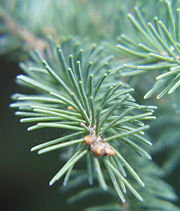Gymnosperm
| Gymnosperms Fossil range: 370–0 Ma Devonian - Recent |
||
|---|---|---|
 White Spruce leaves (needles)
|
||
| Scientific classification | ||
|
||
| Divisions | ||
|
Pinophyta (or Coniferophyta) - Conifers |
Gymnosperm (Gymnospermae) are a group of spermatophyte seed-bearing plants with ovules on the edge or blade of an open sporophyll, which are usually arranged in cone-like structures. The other major group of seed-bearing plants, the angiosperms, [from the Greek, 'angion' - container] have ovules enclosed in a carpel, a sporophyll with fused margins. A carpel consists of a stigma, style and the ovary. The term gymnosperm comes from the Greek word gumnospermos (γυμνόσπερμος), meaning "naked seeds" and referring to the unenclosed condition of the seeds, as when they are produced they are found naked on the scales of a cone or similar structure. There are between 700 and 900 species of Gymnosperm. It is widely accepted in textbooks such as Biology Eighth edition - Campbell and Reece, that the gymnosperms originated in the late Carboniferous period of the Paleozoic era within the Phanerozoic eon. Early characteristics of seed plants were evident in fossil progymnosperms of the late Devonian period around 380 million years ago. Often gymnosperms are used for many economical uses and as folk medicines. Some common uses for them are soap, varnish, lumber, paint, edible plants, and perfumes. Conifers are by far the most abundant gymnosperms with around 600 species. Cycads are the next most abundant group with about 130 species. Approximately 75 - 80 species of Gnetales exist and only one species of Ginkgo remains today.
Gymnosperms are heterosporous, producing microspores from microsporangia that develop into pollen grains and megaspores from megasporangia that are retained in an ovule. Gymnosperm gametophytes are retained in cones of two types. Microscopic male gametophytes are stored in pollen cones and microscopic female gametophytes are kept in ovulate cones. A male gametophyte develops into a pollen grain which is stored within a pollen wall. A female gamteophyte develops from a megaspore and produces one or more eggs. After pollination and fertilization (joining of the micro- and megaspore), the resulting embryo, along with other cells comprising the ovule, develops into a seed. The seed is a sporophyte resting stage. Gymnosperms have a sporophyte dominant life cycle as with all other vascular plants. The seed consists of an embryo, a nutrient rich endosperm food supply and the seed coat or integument. Reproduction in gymnosperms varies greatly. Cycads and Ginkgo have motile sperm that swim directly to the egg inside the ovule, while conifers and gnetophytes have sperm with no flagella that are conveyed to the egg along a pollen tube which grows through the micropyle which is a microscopic gap in the integument of the ovule tissue.
Classification
- Further information: Spermatophyte

In early classification schemes, the gymnosperms (Gymnospermae) "naked seed" plants were regarded as a "natural" group. There is conflicting evidence on the question of whether the living gymnosperms form a monophyletic clade or whether angiosperms evolved from gymnosperms.[1] Numerous fossil gymnosperm clades once existed that are morphologically at least as distinctive as the four living gymnosperm groups, such as Bennettitales, Caytonia and the glossopterids. When these groups are considered, the question of gymnosperm and angiosperm relationships becomes even more complicated.
References
- ↑ Jeffrey D. Palmer, Douglas E. Soltis and Mark W. Chase (2004). "The plant tree of life: an overview and some points of view". American Journal of Botany 91: 1437–1445. doi:. http://www.amjbot.org/cgi/content/full/91/10/1437.
- Burleigh, J. G., and S. Mathews. 2004. Phylogenetic signal in nucleotide data from seed plants: implications for resolving the seed plant tree of life. American Journal of Botany 91: 1599-1613 (abstract)
- Gifford, Ernest M., Adriance S. Foster. 1989. Morphology and Evolution of Vascular Plants. Third edition. WH Freeman and Company, New York.
- Hilton, Jason, and Richard M. Bateman. 2006. Pteridosperms are the backbone of seed-plant phylogeny. Journal of the Torrey Botanical Society 133: 119-168 (abstract)
External links
|
||||||||||||||||||||||||||